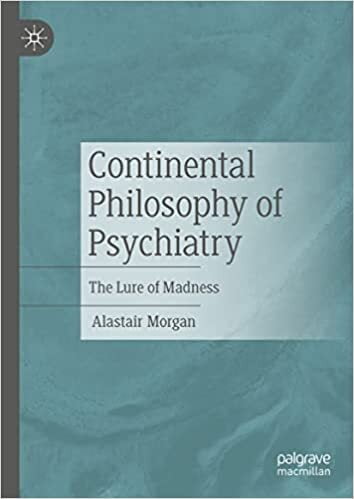Continental Philosophy of Psychiatry: The lure of madness, Alastair Morgan.

Review by Robert Chapman
Philosophical work on psychiatric themes has been around longer – much longer – than psychiatry itself. In Europe, this goes at least back to Plato’s discussions about whether madness can ever be a divine gift. Ancient Confucian and Egyptian analyses of mental disorder date back further still. Analytic philosophy of psychiatry as an established field, though, is much more recent. If anything, it mainly emerged in response to the rise of the anti-psychiatry movement in the 1960s. It was here that Thomas Szasz argued that mental illness was a ‘myth’. While not all anti-psychiatrists held this view, they did all raise vital theoretical questions alongside critiques of psychiatric care and control. Around the same time, a controversy over the wrongful pathologisation of gays and lesbians raised vital questions about where the boundaries of mental health should be positioned. All this showed the urgency of further philosophical analysis of psychiatric concepts.
In response to this, both philosophically oriented psychiatrists and philosophers interested in mental health launched a major research programme in the 1970s. This focused primarily on clarifying the theoretical nature of health and illness as well as on the metaphysics of psychiatric diagnosis. As a result of this, a distinct subfield analytic philosophy of psychiatry slowly began to formalise, hoping to use conceptual analysis to help build a more scientific and perhaps more humane psychiatry. By 1993, the flagship journal Philosophy, Psychiatry, & Psychology had been established. Since the early 2000s, philosophy of psychiatry textbooks have been published regularly, and modules on the subfield are increasingly offered on philosophy degrees.
Unfortunately, one of the most distinctive features about this field, and its surrounding political debates, in its current form is that they have become somewhat formulaic and predictable. For while a range of vital themes are covered – agency and moral responsibility, the nature of delusions, and so on – in certain ways the core debates often seem back in the parameters laid out in the 1960s. In one camp, contemporary anti-psychiatry (now rebranded as critical psychiatry) leaders, mostly clinicians who dabble in philosophy, still regularly claim that psychiatric diagnoses and the very concept of mental illness are normatively laden constructs, and hence, on their view, invalid. For them, mental distress is just a normal reaction to a bad world. In response, philosophers of psychiatry tend to suggest ever more refined metaphysics of illness and diagnosis. This is either through seeking to show that illness or diagnosis are objective or natural, or through exploring the ways in which values are compatible with science. While much of new work on these issues is noteworthy, the debate itself and the blueprints it follows are somewhat stale, even boring.
In this context it is hugely refreshing to read Alastair Morgan’s new monologue, Continental Philosophy of Psychiatry: The Lure of Madness. Wholly sidestepping the blueprint laid down by the analytic and Szaszian traditions, Morgan instead seeks to ‘rescue’ another tradition, which he sees as a distinctively continental one. This tradition always saw madness as value-laden and political – as something always already embedded in a socio-political context – while simultaneously remaining comfortable with the distinctiveness of madness as, at least often, pathological and in need of medical care. In this, the tradition Morgan unveils avoids what he sees as a false dichotomy between medicalisation and politicisation, allowing room for both together, in all their messiness and complexity.
To show this, what Morgan does is trace, with great care and skill, the history of thought of this European tradition, albeit with a focus on madness rather than mental disorder as such. Starting with the familiar figures of Jaspers and Freud, he then seamlessly weaves through the thought of Heidegger, Marx, Fanon, Marcuse, Lacan, and Foucault, among others. Morgan’s method is dialectical – much of his prior work has been on Adorno – leading him to provide a careful study of primary texts alongside the historical context of key authors. In this, Morgan deftly guides his reader through a range of complex debates, expertly synthesising them into a discernible tradition. While the broader tradition Morgan traces is made up of a diverse range of thinkers, what is distinctive about Continental philosophy of psychiatry, is, in Morgan’s terms, that madness itself is imagined as a “dialectic of alienation and transcendence” (2022, p. 6). In tracing this, he covers themes that are often overlooked in analytic philosophy of psychiatry, such as violence and colonialism, allowing him to place philosophical analysis of madness in the context of broader systems of domination.
This tradition even includes a Continental anti-psychiatry, which Morgan contrasts with “Anglo-Amercian constructions of anti-psychiatry” that “produce a vision of anti-psychiatry that is concerned with the British experience and the US contribution from Szasz and Goffman” (p. 384). Instead, through Morgan’s lens, Ronald Laing is considered mainly given his influence from Sartre, especially the latter’s works on Marx. In turn, this is compared with the works of Deleuze and Guattari, written from a French context, and the Basagalians, working to close the asylums in Italy, all of whom took a staunchly anti-fascist stance in their theorising and practice. In this, a distinctive and in certain ways more pluralistic anti-psychiatry emerges. Instead of seeking to normalise madness – that is, to show that it is simply another way of being sane – this anti-psychiatry is concerned with the liberation of mad people, and perhaps madness itself, while holding the distinct reality of madness apart from the forces that seek to erase its recognition. In this, the European kind of anti-psychiatry is not such a break as it is experienced in the Anglophone one, but is embedded much more in the broader Continental tradition.
This overarching thread is important because it allows Morgan to rescue of what he sees as a minority branch of psychiatry that is “pluralistic, creative, and rebellious” (p. 8). From this, inspired by thinkers like Freud, Marcuse and Adorno Morgan urges that madness not “be constructed as so radically other that it cannot speak”, while also cautioning that “to completely dissolve madness intro reason is to ignore a difference of experience that needs to be respected and attended to” (p. 409). In this, while Morgan sidesteps the tired debate between the Szaszians and the philosophical defenders of mainstream psychiatry, he nonetheless presents a stark challenge to both. His challenge, at base, regards the need to hold space for the strangeness, and in some cases, horror, of madness and illness as experienced, while nonetheless resisting individualising and depoliticised framings.
Of course, much of the ground covered is far from new. Morgan’s book retains considerable overlap with existing work in philosophy of psychiatry. Some of the thinkers he covers, from Freud to Foucault, will be well known to those working in analytic philosophy of psychiatry. Moreover, there is already a thriving literature on phenomenological psychopathology that takes inspiration from at least some parts of the Continental tradition. That said, Morgan’s analysis departs from existing work even while covering some of the same content. According to Morgan, for instance, the problem with contemporary phenomenological psychopathology is that it tends to isolate madness, thereby overlooking how madness takes places in contexts of “violence and exclusion” (p. 407). By positioning both the phenomenological tradition and madness in historical and political context, Morgan avoids this, gesturing towards a different way of approaching madness as lived and breathed. In this, Morgan’s book has some similarity with notable works in adjacent fields, such as Louis Sass’s Madness and Modernism or Angela Woods’ The Sublime Object of Psychiatry: Schizophrenia in Clinical and Cultural Theory, which it could be fruitfully read alongside.
Like all attempts at something different, there are limitations to Morgan’s analysis. Despite coming in at over four hundred pages, there is little focus on activist theory developed for political praxis (rather than clinical practice). Discussion of the Socialists Patients Collective (or SPK), active in West Germany during the 1970s and argued that illness should be ‘turned into a weapon’, would have fitted nicely and would have complemented Morgan’s analysis. This is not least since Morgan covers thinkers such as Sartre and Guattari, who were in contact with the SPK and fruitfully engaged with their work.
More recently, the rise of Mad studies and neurodiversity studies would be interesting to discuss alongside the continental tradition. After all, they too provide an alternative to both anti-psychiatry and analytic philosophy of psychiatry, allowing recognition of madness or disability as genuinely different, while also acknowledging their embeddedness in the political. Both these fields have been influenced by thinkers Morgan covers, most notably Foucault. But they have also gone far beyond this, combining critical work on madness with insights and concepts from the field of disability studies to develop new approaches and insights.
The question rises here of exactly who this book is for. In so far as it provides a clear survey of highly complex texts, it could easily form the basis for a module on continental philosophy of psychiatry, or part of a module alongside themes from the analytic tradition. And yet while it would benefit students, it is also so much more than a textbook. In tracing the continental philosophy of psychiatry tradition, Morgan does indeed succeed in rescuing it from obscurity, in ways that will benefit many. For researchers, the book opens many exegetical and conceptual questions, or returns to old questions from a fresh perspective. For clinicians, a rich and pluralistic understanding of madness emerges, holding space for its difference while recognising the contexts of violence and contradiction that produce it. Finally, for activists, it will be helpful to draw on inspiration from this tradition’s rich history of both theory and praxis. As such, there are many who stand to gain from engaging with this important book.
A last thing to say is that Morgan’s rescue mission should not be seen as a finished task (he does not frame it as finished himself). After all, he mainly focuses on a period between 1910 and 1980, this being around the time that analytic philosophy of psychiatry began to emerge. While this was perhaps the high-point of critical analysis of madness from continental social theorists, more recent thinkers, from Mark Fisher’s work on depression through the 2010s, to Beatrice Adler-Bolton and Ardie Vierkant’s excellent new book Health Communism, to Wouter Kusters’ recent Philosophy of Madness, show that this tradition has much more to offer. In this, Morgan’s rescue attempt is best seen as an early step in a direction that is both old and new. By this, I mean it simultaneously looks backward, to an obscured past, while also offering new possibilities for a future philosophy of madness. And this, I suspect, will be anything but boring and predictable.
Robert Chapman, Senior Lecturer in Education at Sheffield Hallam University
References
Adler-Bolton, B. and Vierkant, A. (2022). Health Communism: A Surplus Manifesto. New York: Verso.
Kusters, W. (2020). A Philosophy of Madness: The Experience of Psychotic Thinking. Trans. Nancy Forest-Flier. Cambridge (MA): The MIT Press.
Sass, L. (2017). Madness and Modernism: Insanity in the light of modern art, literature, and thought. Oxford: Oxford University Press.
Woods, A. (2011). The Sublime Object of Psychiatry: Schizophrenia in Clinical and Cultural Theory. Oxford: Oxford University Press.
Alastair Morgan (2022). Continental Philosophy of Psychiatry: The lure of madness. Publisher: Palgrave Macmillan, 434 pages. Available here.
